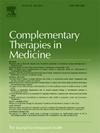介绍一种新的假针灸方法用于双盲试验:一项验证研究。
IF 3.5
3区 医学
Q1 INTEGRATIVE & COMPLEMENTARY MEDICINE
引用次数: 0
摘要
导言:世界各地进行了各种临床研究来评估针灸的有效性;然而,设计一个足够的对照组是具有挑战性的。假针灸工具旨在模拟真实针灸,而无需皮肤穿透,旨在解决这一挑战,但其功效和致盲成功存在争议。方法:在本研究中,我们进行了一项随机,双盲,平行组临床试验,以验证新开发的假针灸方法为未来的双盲试验。66名健康参与者被随机分配到verum或假针灸组。Verum针刺针对常见穴位LI4和ST36,而假针刺旨在模拟Verum而不穿皮,以确保参与者盲化。使用标准化问卷和11分数字评定量表评估致盲(邦氏致盲指数)、穿透、疼痛和deqi感觉。结果:受试者盲法在ST36点被成功维持,而假针刺在LI4点被观察到“更多正确猜测”。此外,从业者随机猜测他们对这两个穴位进行的verum和假针灸。verum组的穿透感和痛感在两个穴位上都较高,而deqi组的感觉则有不同的反应。椎体针刺组和假针刺组均无不良反应发生。结论:新开发的假针灸证明了参与者和从业人员致盲的潜力,特别是在ST36。然而,观察到挑战,特别是在LI4时,表明盲效的局限性。这项研究强调了在更大样本量、不同穴位和特定患者群体中进行额外验证研究的重要性。试验注册:大韩民国临床研究信息服务中心(注册号:KCT0008335, https://cris.nih.go.kr)。本文章由计算机程序翻译,如有差异,请以英文原文为准。
Introducing a novel sham acupuncture method for double-blind trials: A validation study
Introduction
Various clinical studies have been conducted worldwide to evaluate the effectiveness of acupuncture; however, designing an adequate control group is challenging. Sham acupuncture tools, designed to mimic real acupuncture without skin penetration, aim to address this challenge, but their efficacy and blinding success are debated.
Methods
In this study, we conducted a randomized, double-blind, parallel-group clinical trial to validate a newly developed sham acupuncture method for future double-blind trials. Sixty-six healthy participants were randomly assigned to verum or sham acupuncture groups. Verum acupuncture targeted LI4 and ST36, common acupuncture points, while sham acupuncture aimed to mimic verum without skin penetration to ensure participant blinding. Blinding (Bang’s Blinding Index), penetration, pain, and deqi sensations were evaluated using a standardized questionnaire and an 11-point Numeric Rating Scale.
Results
Participant blinding was successfully maintained at ST36, whereas “more correct guesses” were observed for verum acupuncture than expected by chance for sham acupuncture at LI4. Furthermore, the practitioners randomly guessed the verum and sham acupuncture that they had administered to both points. Penetration and pain were higher in the verum group for both points, while deqi sensations had mixed responses. There were no adverse events in the verum acupuncture and sham acupuncture groups.
Conclusions
The newly developed sham acupuncture demonstrated potential in blinding participants and practitioners, particularly at ST36. However, challenges were observed, especially at LI4, indicating limitations in blinding efficacy. This study underscores the importance of additional validation studies with larger sample sizes, diverse acupuncture points, and specific patient populations.
Trial registration
Clinical Research Information Service of the Republic of Korea (registration number: KCT0008335, https://cris.nih.go.kr).
求助全文
通过发布文献求助,成功后即可免费获取论文全文。
去求助
来源期刊

Complementary therapies in medicine
医学-全科医学与补充医学
CiteScore
8.60
自引率
2.80%
发文量
101
审稿时长
112 days
期刊介绍:
Complementary Therapies in Medicine is an international, peer-reviewed journal that has considerable appeal to anyone who seeks objective and critical information on complementary therapies or who wishes to deepen their understanding of these approaches. It will be of particular interest to healthcare practitioners including family practitioners, complementary therapists, nurses, and physiotherapists; to academics including social scientists and CAM researchers; to healthcare managers; and to patients. Complementary Therapies in Medicine aims to publish valid, relevant and rigorous research and serious discussion articles with the main purpose of improving healthcare.
 求助内容:
求助内容: 应助结果提醒方式:
应助结果提醒方式:


